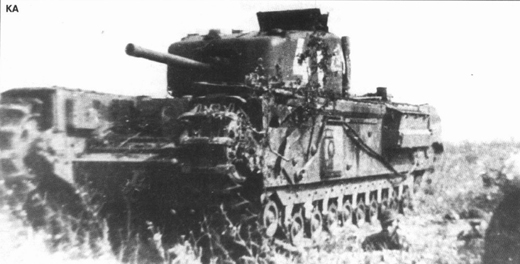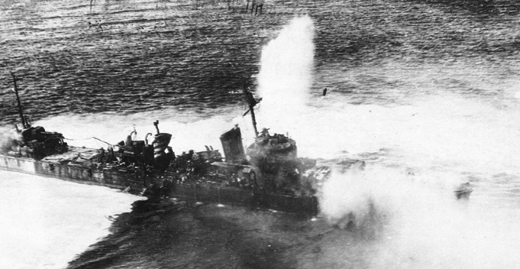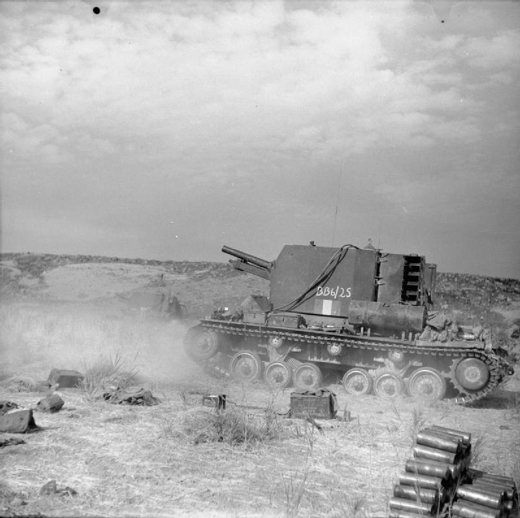Air Operations, Aleutians
28th Composite Bomb Group bombers and 343rd Fighter Group fighters mount 5 light attacks against Kiska.
[Air Operations, CBI
CHINA- 10 308th Heavy Bomb Group B-24s attack shipping in Samah Bay, Hainan Island.
- 6 11th Medium Bomb Squadron B-25s, escorted by 14 23rd Fighter Group fighters, attack targets of opportunity in the Hong Kong port area after failing to locate their primary target, a large transport.
Air Operations, Gilberts
9 307th Heavy Bomb Group B-24s and 6 5th Heavy Bomb Group B-24s stage through the airfield at Funafuti to attack Betio Island in Tarawa Atoll.
[Air Operations, Europe
RAF BOMBER COMMANDEvening Ops:
- 787 aircraft return to Hamburg. In this total are 353 Lancasters, 244 Halifaxes, 116 Stirlings and 74 Wellingtons.
- The center of the Pathfinder marking, all done using H2S, is about 2 miles east of the planned aiming point in the center of the city. The marking is well concentrated, however, and the Main Force bombing 'creeps back' only slightly.
- This is the night of the firestorm, which starts through an unusual and unexpected chain of events. The temperature is particularly high (30° centigrade at 6 o'clock in the evening) and the humidity is only 30 per cent, compared with an average of 40-50 per cent for this time of the year. There had been no rain for some time and everything is very dry. The concentrated bombing causes a large number of fires in the densely built-up working-class districts of Hammerbrook, Hamm and Borgfeld. Most of Hamburg's fire vehicles have been in the western parts of the city, damping down the fires still smouldering there from the raid of 3 nights earlier, and only a few units are able to pass through roads which are blocked by the rubble of buildings destroyed by high-explosive bombs early in this raid. About half-way through the raid, the fires in Hammerbrook start joining together and competing with each other for the oxygen in the surrounding air. Suddenly, the whole area becomes one big fire with air being drawn into it with the force of a storm. The bombing continues for another half hour, spreading the firestorm area gradually eastwards. It is estimated that 550-600 bomb loads fall into an area measuring only 2 miles by 1 mile. The firestorm rages for about 3 hours and only subsides when all burnable material is consumed. The burnt-out area is almost entirely residential. Approximately 16,000 multi-storeyed apartment buildings are destroyed. There are few survivors from the firestorm area and approximately 40,000 people are killed, most of them by carbon monoxide poisoning when all the air is drawn out of their basement shelters. In the period immediately following this raid, approximately 1,200,000 people, two thirds of Hamburg's population, flee the city in fear of further raids.
- 3 Mosquitos are sent to Duisburg, 6 Wellingtons lay mines in the Elbe River and there are 11 OTU sorties.
- 1 Mosquito is lost.
FRANCE:
- 17 323rd Medium Bomb Group B-26s, escorted by 119 P-47s, attack the Tricqueville Airdrome with 18 tons of bombs at 1825 hours. After the bombers are on their way home, the fighters conduct an unchallenged sweep around Rouen.
ITALY:
- NASAF B-17s attack Capua Airdrome and the rail line at Lioni.
Air Operations, Mediterranean
In the day's only air action in the theater, a 414th Night-Fighter Squadron Beaufighter downs an SM-82 transport over the sea west of Sicily.
[Air Operations, New Guinea
18 V Bomber Command B-24s and 35 B-25s attack Salamaua with 133 tons of bombs. 5 B-25s attack barges near Finschhafen. 6 B-26s attack barges and a supply dump at Voco Point.
[Air Operations, Sicily
- NASAF B-25s and B-26s attack the landing ground at Scalea.
- NATAF aircraft attack a wide range of transportation targets and docking areas throughout the island.
- IX Fighter Command P-40s attack shipping at Catania and numerous tactical targets throughout northeastern Sicily.
Air Operations, Solomons
XIII Bomber Command B-17s attack the airfield at Ballale and the Kahili airfield on Bougainville. Nearly 80 AirSols light bombers and fighters attack ground targets at and around Munda.
[Aleutians
During the night the last Japanese leave Kiska. Again the Americans do not spot them. They are preparing for their own landing.
[Allied Planning
AFHQ direct the CG, 5th Army, to prepare plans for the capture of Naples and nearby airfields from which future operations in Italy could be supported. D-Day, which is to depend upon the phase of the moon and the availability of landing craft, is tentatively set as 7 September. The British planners are already working on plans for Operation BUTTRESS
[![]()
![]() |
| ![]()
![]() ]
]
Britain, Home Front
Churchill declares in the Commons that if the new Italian government does not surrender 'Italy will be seared and scarred and blackened from one end to the other.'
[ 'Chucrchill' IV Tank of the 10th Guards Tank Regiment |
 |
CBI
INDIA:The Chinese-American Composite Wing (CACW) is activated in the 14th Air Force at Karachi, India. The wing consists of Chinese aircraft and pilots trained under lend-lease.
[Germany, Planning
At a conference called to decide a plan of action in Italy, Hitler and his staff work out the order of steps to be taken: one, liberation of Mussolini, called Operation OAK TREE; two, occupation of Rome and restoration of Mussolini in the government, called Operation STUDENT; three, military occupation of the whole of Italy; and four, capture or destruction of the Italian fleet. Mussolini in fact is to become another 'Quisling' puppet leader.
[India
A Chinese-American squadron is formed within the US 14th Air Force, with American-trained Chinese pilots.
[Italy, Home Front
In the evening Mussolini is transferred from Rome to the island of Ponza.
[New Georgia
The 37th Division temporarily suspends the attack on Bartley Ridge in the center and begins to assault a feature on the left called Horseshoe Hill, reducing several pillboxes. The 148th Infantry gains a tenuous contact with the 161st, but a gap still remains between the 2 regiments.
Japanese Destroyer Mikazuki Under Attack |
 |
Pacific
- In the 'Battle of the Pips', the battleships Mississippi (BB-41) and Idaho (BB-42) engage imaginary 'Japanese battleships', spotted on radar near the Aleutians. The only Japanese vessels in the area are submarines.
- The US submarine Scamp (SS-277) sinks the Japanese submarine I-24 off the Admiralty Islands.
- The Japanese minelayer Hirashima is sunk by the US submarine Sawfish (SS-276) off Kyushu, Japan.
- The Japanese merchant caro ship Teiken Maru (1972t) is sunk by a mine off Hainan Island. The mine was laid by the US submarine Tambor (SS-198) on November 2, 1942.
Sicily
Units of the 45th Division advancing along the coast road towards Messina reach Tusa, a few miles west of Santo Stefano. They cross the river of the same name but are driven back. They later cross the Tusa River again and succeed in establishing a small bridgehead in the direction of Santo Stefano. After 3 days' hard fighting Nicosia falls to the American 1st Division. In the British sector the Canadian 1st Division takes Agira after a tough battle. Meanwhile the 231st Brigade resumes its advance eastward along Highway 121, but is held up a few miles west of Regalbuto.
Gen Alexander, the commander of the XV Army Group, moves his headquarters from Africa to Sicily. The headquarters of Allied forces in the Mediterranean asks for consideration to be given to a plan for the capture of Naples and the neighboring airports as a base for the support of future operations. The date for the landing is fixed, purely provisional, as September 7.[MORE]
A Bishop of the 142nd Field Regiment |
 |